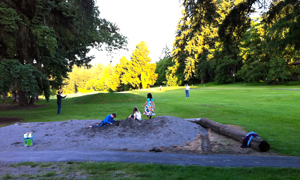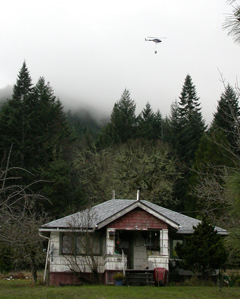
NEW: See the video by Beyond Toxics volunteer Douglas McGowan of how the rural residents of northern Klamath County were doused with a deadly pesticide in 2010. (near top of the page)
Spring in Salem
In the springtime the Oregon State Capitol mall is a beautiful place to visit. On a sunny spring day I was walking through the mall on my way to the Capitol building. Ahead of me, there was a mother walking on the sidewalk with a toddler by the hand and a baby in a stroller. As she talked with her excited toddler and pushed the stroller, she unknowingly walked through a cloud of mist – coming from the nozzle of a sprayer. She kept going, but I stopped to ask the state employee what was in the mist. He replied that he was spraying glyphosate, an herbicide suspected of being a hormone disruptor and linked to learning disorders.
So, this mother had unwittingly exposed her young children to a poison, simply by taking a walk on state grounds. Should this mother expect to be safe in a public facility? I’m a mother, and I know that I had always assumed that my children would be safe in a state park or in and around state buildings. How many of you--in walking through a public park or walking near a state or county services building--could possibly walk through pesticide residue, drift or vapors without knowing it?
Lisa Arkin, Executive Director
Beyond Toxics
"Herbicide Application in Progress" near Hendricks Park
In her letter to the City of Eugene's Division of Public Works, Eugene resident Ann Kneeland described her pesticide exposure this way...(followed by a plea for greater care and better public warnings)
Here’s what I experienced: On the morning of Friday, April 22, 2011, a beautiful sunny day, I took my 20-month-old son to Hendricks Park for a walk and some play. Just a few minutes beyond the parking lot (just across Summit Avenue toward the Rhododendron Garden), I saw a woman along the tree line with a pack on her back and a wand swaying over the foliage in front of her. As if the equipment did not reveal her activities, she was carrying a small sandwich-board sign that read “herbicide application in progress.”
From about 100 feet away, I called to her to ask her what she was spraying. Very kindly and patiently, she yelled back to me across the distance, telling me the herbicide she was spraying, for what plant and when the Park generally sprays. She also advised that this was not a good day to be in the Park. Unfortunately, I can’t remember most of the details of the herbicide or offending plant, but what I do remember clearly are the following thoughts:
• Why is the only sign about this herbicide application in the staff member’s hand as she weaves in and out of sight around the bushes?
• Why was there no notification visible anywhere else along Fairmount Boulevard (my route) or in the parking lot about the herbicide application?
• If I had not seen her, how long would we have walked and played in and around the flower beds where she was spraying?
• How many other people are enjoying the park oblivious to the herbicide application in progress?
• Why was this staff person not wearing any protective gear?
As I left, I notified two people with a dog about the spray across the street. They informed that they had just left Doris Ranch for the same reason, thanked me for the notice and left immediately.
I understand that people have differing tolerance for and opinions of herbicides. Although I oppose their use, I now know that Hendricks Park uses herbicides to manage undesired plants. However, I doubt that the City of Eugene, the grounds keepers of Hendricks Park and most members of the public would feel comfortable with a small child playing in the drift or residue of herbicides.
As an individual and mother who takes great pains to keep my family, and especially my son, away from pesticides in our food, water, garden and environment, this incident at Hendricks Park was alarming and disheartening.
Please make greater efforts to notify the public of your planned and in progress herbicide applications. In advance of the application day, you could notify the public in the Lane County Herbicide Spray Schedule in the Eugene Weekly. In the days immediately preceding, during and after the application, you could post numerous stationery signs at the entrances, along trails and in the parking areas of the Park.
Hendricks Park is a beautiful and peaceful place to walk, run, picnic and play. Please make sure it is also a safe place to be for everyone!
Sincerely yours,
Ann B. Kneeland
Oakway Mall Spraying - 2010
...from Lynn Bowers, Beyond Toxics member:
This is the story of how I got poisoned twice in the same place. (HEAR THE AUDIO RECORDING)
January 18, 2010 1:30 p.m. Shopping Mall Parking Lot:
I walked around the corner of the building to find two herbicide applicators all suited up: masks, rubber suits, boots, and gloves. I kept to my car as fast as I could walking between them I called out, “Okay for you guys all suited up! What about the rest of us?” The one guy approached my window asking me to open it so we could talk. I could hear him explaining that they just had to wear this equipment because they are workers that use the poison all the time but it wouldn’t hurt me. I was already reacting so I drove off pronto. It takes me about twenty minutes to get home. Getting out of my car I take my own picture. I go into my mudroom, strip down to naked and throw my winter coat, shoes and everything into the washer, shower for fifteen to twenty minutes. While getting myself some lunch I call the owner of the mall and the landscape service manager and say I want to report an exposure incident and make appointments to discuss it. The next day, I meet with the mall owner and the young woman who takes care of the interior landscape at the mall. They assure me that they don’t use any chemicals inside. The owner is humoring me. She says, “You should get yourself a soapbox!” I assure her that my cabinet maker husband has already built me one that I haul to wherever I need it. We actually keep it on our front porch. Then I drive across town to the office of the prominent local Green Image Landscape Product Company and tell my story all over again. They can hear me throughout the building. At my insistence he gives me material safety data sheets for the pre-emergent products used: Snapshot and Kazeron. He states that, quote: “The public interface is bad.” We conclude with him agreeing that the company will not use these products at the mall or any other equivalent public place.
Forward to April 18, 2011 11:40 a.m. Same parking space
Getting out of my car I notice I am parked tail-to-tail with a landscape truck. Always curious about their operations I walk toward the truck and simultaneously start reacting and notice a worker with a backpack sprayer walking away from me. I go do my grocery shopping quickly, about ten minutes, and when I approach the front of my car I notice a chemical smell and see that there is a liquid spill beneath the tail of the truck that has evaporated. I go on to Sheldon Pool where I borrow a phone book from the front desk. I have trouble trying to figure out how to find the number of the landscape service. Getting Kevin on the phone I am so aphasic that I can barely make words.
Me: “Kevin I was just poisoned again at the mall. I thought we had an agreement?”
Him: “I can tell you that we stopped using all pre-emergents.”
Me: “Call me at home and tell me what it was.”
When he does call I say, “Your discontinuing pre-emergent’s does give me better odds of getting to the grocery store without being poisoned, but even once is just too much.”
I shower for ten to fifteen minutes there at the pool and am in the pool by 12:15 for one hour and am feeling some better. When I’m home Kevin calls me and tells me that the products used were Round-up and Speedzone applied as spot treatments. Quote, “Only on the perimeter” and quote, “near the offices and Pier One.” And I say, “Well what’s Speedzone?” And he replies, “A broadleaf herbicide.” And I’m wondering does he know what’s in it. Why doesn’t he tell me if he knows?
April 19th, the next day I get a printout for the label Speedzone. It contains 28.57% 2-4-D Ester, Dicamba and two other poisonous chemicals. The label says, “Do not apply this product in a way that will contact workers or other persons either directly or through drift.” Other quote: “Do not enter or allow people or pets to enter the treated area until sprays have dried.” And I’m wondering where there entry barriers or any other form of notification at all there at the mall? I’m thinking probably not, I bet the mall owners wouldn’t like that, so they do it in secret instead?
April 20th, here’s my notes made that morning:
Morning, I’m still reacting, I still have red face, I still have that characteristic taste in my mouth and numb lips. And in the middle of the night I could taste the chemical. I call Kevin to discuss Speedzone. They were spot treating oxalis in flower beds and he said that he would not use Speedzone again. I said, “Are we going to have to slug it out over again for each separate product?” He tells me about organic products that they had investigated that were too dangerous to use. I asked him if he heard of Green Match? He called back to say that he had read the label for that product on the internet and that it looked good and he was checking on local availability. I tell him, “Well you know Kevin; education is a lot more efficient then litigation.”
 Laurelwood Golf Course Spraying
Laurelwood Golf Course Spraying
...from Charlotte, a Beyond Toxics member:
I was again shocked this morning to see further and even more dangerous spaying on Laurelwood Golf Course. This golf course is owned by the city and is a public facility. I took photos of direct spraying on areas of small stream beds and water drainage areas. There was also a beautiful area that has grown native Fawn Lilies, Wood Violets and Camus -- today that area is a dead zone. The areas where these flowers have traditionally grown for the 35 years I have lived here have continued to shrink every year since new management.
I have also noticed what I would call the collapse of the Laurelwood frog colony. While previous to the June 1st spraying of the stream beds, there was an amazing chorus of frog-song every night whenever temperatures reached about 50 degrees. I have not heard one frog since that infamous event.
Also, there is a pile of sand where kids often play--was completely surrounded by dead zone due to spray - even where kids put their coats. I saw children playing there just the other day. Children are often using areas of the golf course because the lodge is often rented out for private events such as weddings, birthdays, and community meetings.
Many neighbors use the natural open space as a place to walk, take a pet, and commune with nature. I am quite concerned that my dog, who I took for frequent walks in the open areas of this public golf course, recently died of seizures. While I can’t absolutely prove anything, I believe that the seizures may have had something to do with the fact that some of the pesticides that were sprayed are known neurotoxins. The increasing use of herbicides on the golf course over the last few years lends some credibility to my fear that my dear 6 year old dog’s suffering was related to the pesticide use.
We must do something to stop this rampant spraying.
Charlotte
 Personal Narrative about Forestry Uses of Pesticides
Personal Narrative about Forestry Uses of Pesticides
I grew up on a farm on the Luckiamute River in western Oregon. My family's entire income came from raising cattle and logging. I put myself through college setting chokers in the woods. Four of my siblings still make their living from either agriculture or logging. I am still a member of a family partnership which owns timberland and engages in sustainable timber harvesting.
I ended up going to medical school, and I have been practicing internal medicine in Eugene and Springfield since 1985. I offer these thoughts wearing three hats.
1. With my background, and as a member of the family partnership, I understand the economic importance of timber harvesting in Oregon.
2. As a physician, I am aware of the evidence of medical harm to humans and animals caused by current pesticide practices.
3. I am also a concerned citizen who does not want to allow the environmental and public health harms of pesticides to be denied and downplayed.
I have two personal anecdotes to relate.
While growing up, I was exposed to occasional pesticides on our farm when we sprayed thistles and tansy. In 1969, I took a job for a month of killing maple trees in OSU's McDonald Forest. I carried a backpack of a pesticide connected to a special hatchet that injected the pesticide into the sapwood when I struck the trees. At the end of each day, my skin was covered by an oily film and I even would occasionally get it squirted in my eyes. At age 50, I was diagnosed with prostate cancer. There has never been prostate cancer in either side of my family. Is this just a coincidence? Maybe, but there is no way to be sure.
In 2000, there was a huge clear-cut of multi hundreds of acres on a large steep hill behind my family's farm. It was then sprayed with pesticides for 3 consecutive years. When I walked around the area, there was no life except the Douglas Fir seedlings that had been planted. Everything else was dead. There were no deer tracks, insects, or birds. During the next few years, there were several landslides in the area. The hill is the origin of the creek that flows through the farm. Water from the creek is used to irrigate the vegetable gardens, and the livestock drink from it. I formed the opinion then that this cannot be good.
In medicine, we use the concept of risk:benefit ratio every time we recommend a treatment. On an almost daily basis, we make decisions to not recommend a treatment that might provide benefit to a patient, because, in our judgment, in a given case, we feel the risk that the treatment could cause harm outweighs the benefit.
I accept that large scale pesticide spraying of clear cut areas yields economic benefit compared to not spraying. However, the benefit is not that great. You can still grow a fine forest by replanting without spraying.
This benefit must be balanced against the harm it causes.
From an environmental standpoint, the soil degradation, landslides, loss of insect and wildlife, and destruction of healthy diversified flora cannot be ignored.
And lastly, this is a public health issue. The evidence of long term harm to human health cannot be ignored.
Richard Barnhart, MD, FACP
In 1988 my husband and I bought our home in the Northwest Oregon Coast Range. We had looked all over the western states to find our “special place”. When making our decision we had several criteria which included seclusion, quietness, true darkness, clean air and pure water. Living where we do has not been easy, it is a long way to commute to any type of employment but we made that decision in order to have a healthy home and lifestyle.
We are both cancer survivors and have been totally committed to living chemical-free for many years….From the beginning we have maintained our 19 acres by hand, using no chemicals to control blackberries or other weeds. We have had the county not spray the public road that borders our property and we have brushed that by hand so no chemicals would be sprayed. This lifestyle choice has been expensive and hard work but our health and that of our grandchildren has been our first priority.
It is now ironic that we are imminently subject to an aerial application of the deadly herbicide, Accord whose main ingredient, glyphosate is classified by the EPA as “extremely persistent.” It [glyphosate] has been proven to persist in soil for 1 to 3 years and in water for over one year. Helicopter applications such as proposed next door to my home have been shown to have “drift” of the chemical to at least 656 feet. My domestic water system is a shallow well, with my only source of water taken from a few inches underground. The source of that underground water is a spring high on the ridge that has now been clear cut. It flows about a mile as surface water before we capture just below the surface. Direct contamination is likely from the initial spraying. What is even more disturbing is that with its known persistence in the soil and the large amount of rainfall here, the chemical will be consistently moving into the waterway every time the soil moves. Oregon Department of Forestry’s (ODF) staff have stated that the “Terrain is moderate to steep and precipitous. Slopes range from 20 to 80 percent.” and “The subsoils are susceptible to sliding on precipitous slopes and steep landflows.”
It feels like my fundamental right to security of person is going to be violated through exposure of myself, my family and my property against my will. Human rights norms are not arbitrary. They are ethical standards recognized by citizens in our country and by peoples around the world as moral duties and protections that everyone should be able to expect from their governments. If governments, or businesses regulated by governments, violate these norms, they are violating formally recognized standards of justice.
If civil laws represent hard legal boundaries outside of which certain behaviors are not legally permissible, human rights standards represent hard ethical boundaries outside of which certain behaviors are not morally permissible.
When there are questions about the long term health effects this application will have, the only prudent course of action is to err on the side of caution. While I oppose the use of herbicides completely, at least hand application would offer more control and less drift hazard to my water and land.
Clatsop County resident
DO YOU HAVE A PESTICIDE EXPOSURE STORY?
Write to us: info@beyondtoxics.org
or
call the Beyond Toxics office in Eugene: 541-465-8860
MORE
- Safe Public Places Resources page
- Read our Safe Public Places flyer
- Back to Safe Public Places project home page
- Chemical Trespass and Human Rights (pesticide exposure stories on video)
Show your support for the Safe Public Places Act by signing our campaign endorsement form. A list of endorsers will be submitted to the Oregon Legislature to support the bill.
Now you can designate that your donation go directly to this great program when you join! After clicking on the orange button (below), simply choose "Safe Public Places." from the “Program Designation” drop-down option.
Beyond Toxics is a 501(c)(3) non-profit organization and all contributions are fully tax-
deductible. Please consider giving a gift of a Beyond Toxics membership to a friend or family member!





